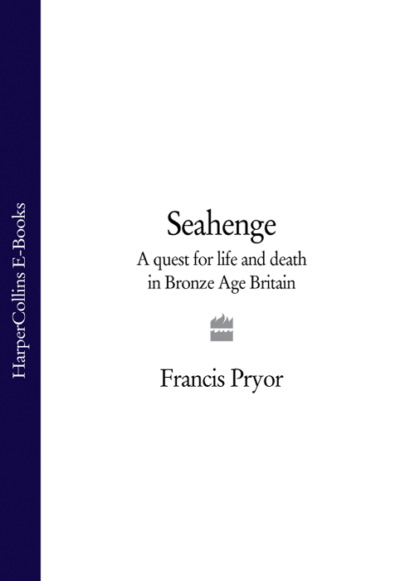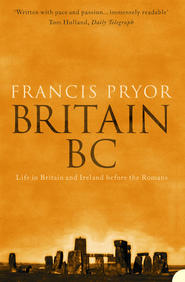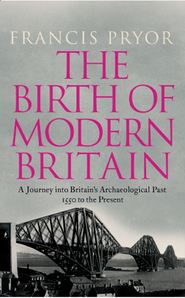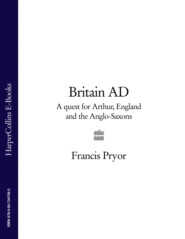По всем вопросам обращайтесь на: info@litportal.ru
(©) 2003-2024.
✖
Seahenge: a quest for life and death in Bronze Age Britain
Автор
Год написания книги
2019
Настройки чтения
Размер шрифта
Высота строк
Поля
As if to clinch the matter, the only find from either of the two ditches was the fragment of a Neolithic polished stone Langdale axe. In the New Stone Age (which is what ‘Neolithic’ means) stone was the most important material for making edge-tools, such as axes. Some stone was much better for this purpose than others, and became much prized. Like many things we humans touch and cherish, there was a fine balance between beauty and utility. And the most beautiful stone of all was quarried high in the mountains of the Lake District, at a place called Great Langdale.
Langdale stone is hard, fine-grained and a subtle greyish-green in colour. It looks even better when polished to a silky sheen – and Neolithic axes were almost always patiently polished to a fine, smooth finish. As well as Langdale there were other so-called ‘axe factor’ sites in Britain, in Wales, Cornwall and elsewhere, and they all exported their products to distant parts of the country. A large number of Langdale axes were sent to communities on the other side of the country. Fengate, for example, is 175 miles south-east of Langdale. There seemed little doubt that the two shallow ditches were Neolithic – and probably Earlier Neolithic, too. I would guess they were dug well before 3000 BC.
As I’ve already mentioned, the rectangular house had produced many finds, including some rather unusual pieces. One of these was a large flake that had been deliberately removed – with a sharp blow – from a polished Langdale axe. Another was a beautifully-made and highly-polished jet bead. This wasn’t a little bead – it was large enough to have just covered, say, the top joint of one’s thumb. Jet is a shiny, coal-like material whose nearest source is the beautiful Yorkshire seaside town of Whitby, some 130 miles to the north of Fengate. In addition to these rare finds there was a lot of fine pottery and a remarkable collection of flint implements, including a most unusual and beautifully-made sickle blade in lustrous blue-black flint.
I returned upstairs from the basement and spread some of the finds from the rectangular house on my desk. They really were beautiful. Could they, in all truthfulness, have been cast aside as debris – mere rubbish, the sweepings off the kitchen floor? As I handled the large flake of Langdale stone, my doubts vanished. I was now certain that the rectangular building was not merely a house. It had to be a special place.
I must now take the story temporarily forward a few years. I completed the Fengate project in 1978, and spent the next two years writing the final two reports, which were published in 1980 and 1984. Part of my background research included a detailed survey of all previous excavations in or near Fengate. The last excavation to have happened before our campaign began was in 1968, at a place called Site 11.
The site was first spotted on an air photo, as a cropmark, and it looked a bit strange. It consisted of a straight-sided rectangular enclosure, defined by a continuous single ditch, with sharp corners. It measured about fifty by thirty metres, but there was no sign on the air photos of an entrance of any sort. This made me sit up and take notice. The excavations produced decorated pottery and flint tools in the distinctive style of the Early Bronze Age Beaker ‘Culture’. In the brief report that appeared shortly after the dig, it was suggested that the enclosure and the pottery belonged together, and that the whole site was a small farmstead or settlement of some sort. This seemed a quite reasonable conclusion at the time, but when I came to reexamine the Site 11 report at the end of the Fengate project, I couldn’t reconcile it with what we had found. It simply didn’t fit in.
By now alignment and orientation were becoming something of an obsession with me. I checked the orientation of the Site 11 enclosure, and it bore no relationship at all to the Bronze Age fields in which it was supposed to sit. If the dating of either the fields or the enclosure was correct, they had to have been in use in the first few centuries of the second millennium BC. So how could they fail to share a common alignment? It didn’t make sense.
This was something of a side-issue to my main work, the writing of two large reports, and I resolved to go back to the original site notes and records from 1968 to see if they would clear matters up for me. They did, but in a completely unexpected fashion. In one of the notebooks I came across an unpublished pre-excavation pencil sketch-plan. It was a good sketch-plan, and was annotated in an elegant italic hand. Subsequently it had been scratched out by, possibly, a different hand. The features shown in the initial sketch bore an uncanny resemblance to the first Bronze Age roundhouse we had excavated back in 1974. Everything was there: the front-door posts, the ring-gully eaves-drip gutter; even the alignment of the doorway was right. It was simply too good to have been invented.
FIG 5 Ground plan of Fengate Site 11, showing the position of archaeological trenches
When I examined the records further, it became clear that the Early Bronze Age Beaker pottery came from this house and from features, such as fireplaces, that may have been part of it. There was no reason to suppose that the rectangular enclosure had anything to do with the house at all. They could have been constructed centuries, even millennia apart.
It felt good to have sorted this little problem out. But why didn’t I pursue the matter further? What about the rectangular enclosure, for Heaven’s sake? I suppose I was too keen to get back to the writing of those two great volumes. But I had missed a trick. It was to be another five years before the next piece in the jigsaw fell into place.
I was spending the weekend with the eminent authority on the Neolithic period, Dr Ian Kinnes, at his house in Guildford. On the dinner table before us were drawings of Neolithic pottery from Etton, the site I was then digging and which I’ll discuss later. The drawings were annotated in Ian’s elegant italic hand, and suddenly I remembered the handwriting in the Site 11 notebook. Was Ian the supervisor who made those notes, I asked. He was. It was a part-time job he’d done while he was a post-graduate student at Cambridge.
He couldn’t remember why his sketch-plan had been crossed out, and he shared my view that if the structure was indeed a Bronze Age roundhouse, then it went with the later fields, and not with the enclosure.
I was thinking aloud. ‘So that leaves the enclosure high and dry, I suppose?’
‘Oh, no it doesn’t,’ he said. ‘Quite the opposite. That house was always a problem. Take the house away, and you’re left with a mortuary enclosure – like the ones that turned up the other day on air photos in Essex.’
An article about the Essex enclosures had recently appeared in an academic journal, so I was familiar with what he was talking about. Mortuary enclosures and structures were special places that were constructed in the Neolithic and Early Bronze Age to receive recently deceased corpses. By and large, they do not seem to have been used as permanent resting places, although burials are often found in them. Sometimes, indeed quite often, the enclosure takes the form of a surrounding wooden wall, or even a roofed building. More often than not, the original enclosure may become incorporated within a later burial mound, or barrow. In short, they are complicated sites and are probably best considered one at a time, as individuals.
As soon as I returned home, I unrolled my well-used Master Plan, which was now rather grubby and dog-eared. I had not added the Site 11 enclosure to it, as my team hadn’t dug it. As I was drawing it in in its rightful place, I was immediately aware that its alignment precisely followed that of the ‘house’ and the pair of shallow ditches at Vicarage Farm. All four Neolithic sites appeared to process across the Fengate landscape in an orderly row, from north-east to south-west. It was quite extraordinary.
By this time I had come to the conclusion that the ‘house’ we had dug in 1972 was a mortuary structure, but without a body. Some mortuary structures, indeed most barrows as well, are thought deliberately to echo the houses of the living – as Houses of the Dead. Certainly the rich finds from the ‘house’ would be appropriate for a mortuary house.
FIG 6 Ground plan of the Neolithic mortuary structure at Fengate discovered in 1997 by the Cambridge University archaeological team
The latest piece of this jigsaw, which so far has taken over a quarter of a century to assemble, fell into place in July 1997. By this time the old way of doing research, in which a local team tried to grapple with the particular problems of a given region, had been replaced by the modern system of competitive tendering, where the lowest price wins. All too often this system produces half-digested results that are not adequately tied into the regional story. The work is done for money – and it shows. But in this case the project, at the edge of my earlier
Cat’s Water excavation, was won by a team from Cambridge University, with which I have always been friendly. They did an excellent job, and kept me closely informed. However, this was a truly independent excavation – independent of me and my pet theories, that is.
The Cambridge team were digging at the extreme edge of the wet ground on a low gravel knoll, which reached out a short distance into the shallow waters where peat had begun to form around 2000 BC. On this knoll they found a rectangular arrangement of small pits and post-holes and a collection of finds which included big pieces of Neolithic pottery, but no animal bones. As with the ‘house’ I had dug twenty-four years previously, it would appear that the objects found in the ground were not a random selection of household debris, but gave every appearance of having been carefully selected. Quite independently, the Cambridge team interpreted their site as a mortuary structure. And when they came to plot its position on the map, lo and behold, it was orientated north-east to south-west; what is more, it lined up beautifully with the other four Neolithic sites.
It had taken nearly twenty-five years to uncover evidence to support my original theory. It was now clear that the landscape had changed its orientation sometime between four and five thousand years ago. But why? And what did it mean? Most important of all, why was there this emphasis on death, with a multiple burial and three mortuary structures?
CHAPTER FIVE Gardens of Creation (#ulink_6e9f650d-6acb-5dc7-8f88-e0d6fe510de9)
MY QUEST INTO the lives of prehistoric people was taking me in unexpected directions – such as, for example, Death itself. I knew that I wanted to bring their world forward, into our time, but I was finding myself being drawn back further and further into theirs. It was as if I was the centre of a ghostly tug-o’-war. I felt they were leading my footsteps, holding my hand, like wise grandparents with a young child. Where, I wondered, were they going to take me next? The quest was now about to enter a philosophical, almost a mystical, stage.
I was facing some of the Big Questions of human existence. I knew full well that I could never do these Big Questions justice, because – like most of my colleagues – I simply don’t possess the necessary philosophical background. Having said that, I feel it is arrogant in the extreme to dig up religious and mortuary sites without making at least some effort to understand what those places might have meant to the people who built them.
I should have realised that one cannot hope to understand the lives and deaths of ancient people – any people – if one chooses to ignore their history. By history I don’t mean a dry account of a succession of archaeological ‘cultures’, or indeed of presidents, prime ministers, kings or queens. I mean history in the sense that we all understand it, as a series of stories about the past that provides us with an all-enveloping explanation of why and how we are here. The Battle of Britain affirms my reluctant feeling of patriotism, and tales of my grandmother – such as the time she was supposed to have wrestled a crocodile to its death somewhere in India – make me feel part of my family. We each have all sorts of histories: individual, family, local and national. All of these different stories comprise history as it affects our daily lives. Prehistoric people also had histories of this sort, and they were probably equally old, odd, at times jingoistic and improbable. But the huge time-span of archaeology has taught me that the individual events of history don’t matter. It’s the broad pattern and purpose behind them that tells a human story.
It began to be apparent to me that my interest in landscape development was fine as far as it went, but it was too impersonal. To see things from the perspective of once-living people, I had somehow to take myself back; and in such a way that I could imagine what their histories might have included. What, for example, might Bronze Age folk have seen as The Beginning? All societies need Creation myths. Today, if we are unbelievers we have the Big Bang, if we are Christian we have Adam and Eve in the Garden of Eden, and there are hundreds of others. Creation myths justify our place in the world and give us a sense of belonging.
The story of human beings is essentially one of continuous change and gradual development. There are few times when the whole world is suddenly turned on its head. One such occasion was undoubtedly the Industrial Revolution. In archaeological terms it was remarkably swift – a mere two to three hundred years at the outside – and nowadays there is hardly anywhere on the globe that has not felt its effects. Hidden within the Industrial Revolution were other revolutions, which could not have taken hold without the new context created by the industrial world – revolutions such as the Agricultural Revolution or the Medical Revolution. Currently we all have to grapple with a great-grandchild of the Industrial Revolution, the Information Revolution, which some of us have attempted to master with greater or lesser success.
There is something rather attractive about the idea of revolutions. They imply phenomena bigger than mere human beings. A revolution is something that happens despite our wishes; it has a momentum all of its own. There is more than a hint of the hand of God. So when in the 1930s someone suggested the notion of the wonderfully portentous-sounding Neolithic Revolution, the archaeological community greeted it with acclamation.
The Neolithic Revolution was quite simply the invention or beginnings of farming. From this came settled life, the production of pottery and a number of other typically Neolithic traits, such as the use of polishing, instead of chipping or flaking alone, to make stone axes. Communal tombs and villages also came with the Revolution. It was an attractive idea, and in certain parts of central and southern Europe the spread of the new Neolithic way of life must have seemed like a revolution.
I was taught about the Neolithic Revolution at university; then the first radiocarbon dates, those ultimate spoilsports of our subject, came along and showed that, as revolutions went, this one was slow (in Europe it lasted for about three millennia). Further dates then demonstrated that it happened at various times in different parts of the world, which makes the use of the singular word ‘revolution’ problematical.
The core of the original Neolithic Revolution concept was the invention of farming. This too was sometimes given a portentous-sounding definition – like, for example, the shift from hunter-gatherer to food producer. Unfortunately the basis of the ‘Neolithic Revolution’ was flawed. It assumed that a clear, distinct and rapidly-formed fault-line separated food producers from those who hunted and gathered. But it was not as simple as that.
Research into modern hunting-and-gathering communities has shown that they don’t simply breeze through the woods plucking ripe mulberries when the mood takes them. Their way of life is far more rich and complex. For a start, they conserve and husband their resources. And it’s not a big step from husbanded resources to animal husbandry – which of course is an important form of farming.
Another precept behind the Neolithic Revolution was the idea that hunter-gatherers spent most of their time and energies gathering nuts and berries or stalking elusive deer. Farmers, on the other hand, were thought to have the time to sit around the family hearth, recite myths and legends, and generally develop a rich and complex ideological world. I remember attending a lecture in Canada by the University of Toronto anthropologist Richard B. Lee, in which he turned this idea on its head. He showed that the Bushmen of the Kalahari Desert of southern Africa were so efficient at procuring their food that they had plenty of time to weave the richest of ideologies; the same can be said for the Aboriginal peoples of Australia. Meanwhile farmers had to spend wearisome hours guarding their crops and flocks, while in constant pain, unable to focus their thoughts, as dental caries ate into their teeth – a condition rare amongst hunting societies.
Research into the lives of hunting people has also shown that they conserve prey with great care. They encourage beasts to congregate in the same places, such as clearings made around watering-holes, so that the hunters are not forced to take part in long-distance stalking. The idea is to hunt efficiently and not to expend energy unnecessarily. The difference between encouraging wild animals regularly to enter a clearing, and actually farming your own domestic flocks, seems pretty minimal.
Large parts of lowland Britain were covered with forest after the retreat of the last Ice Age some twelve thousand years ago. We know this from the patient work of archaeological scientists over the past sixty or seventy years. In the 1930s and forties Sir Harry Godwin and other pioneers of pollen analysis were able to reconstruct past environments by identifying and counting prehistoric pollen grains preserved in lake beds and peat bogs. Their work was to inspire contemporary archaeologists and other environmental scientists, who then turned their attention to our subject.
One might reasonably ask how hard science can possibly help us investigate something as deeply rooted in the world of the imagination as a myth of creation. The answer is that archaeological science has become far more than a mere ‘add-on’ to conventional archaeology. Science, and most particularly environmental science, allows us to recreate the surroundings in which people lived. We have learned that past communities did not merely react to changes in their natural environment; they helped to cause changes, then modified the landscape and the way they lived within it once the changes had happened. We now know that this relationship between people and their landscapes was both subtle and complex. And we owe many of these insights to science.
Some archaeologists have acquired a full scientific training; they still see themselves first and foremost as archaeologists, but with specific scientific skills. Like any non-scientific archaeologist, such as myself, their main interest is in past people. Science is just a technique that allows them to approach this ultimate goal.
One of my oldest friends and closest colleagues, Charly French, is Canadian. He was a key member of the various teams I led from 1975 until 1989, and he wrote his doctoral thesis, for the Institute of Archaeology, London University, on the ancient environment of Fengate and the Peterborough region. In those days his main techniques were sediment and molluscan analysis, which perhaps need a few words of explanation.
Sir Harry Godwin showed how the analysis of preserved pollen grains could help recreate the numbers and types of plants that were growing in the past at any particular time. This general approach works well for other things too. The shells of molluscs, of which snails are the most commonly found, resist decay quite well and are often preserved in the ground. We’re all familiar with large garden snails, a common species of which was introduced to Britain by the Romans as an edible snail. But there are also hundreds of other, much smaller snails which lurk in shady spots, in water, in ditches or even underground. Snails are fussy about the conditions they require.
The technique of molluscan analysis takes all snails, great and small, from a sample of ancient soil and uses the ‘fussiness’ of the individual species to draw a picture of conditions in the past. So if you find species of snails that like it wet alongside those that like it dry, you can reasonably assume that the local environment was regularly flooded, but dried out in hot seasons. Unlike pollen analysis, which receives pollen grains from miles away, molluscan analysis paints on a smaller canvas; but sometimes the pictures can be remarkably accurate.
Charly’s other skill in our early days together was sediment analysis. This is a geological technique which examines the physical composition of a soil or sediment. The size range of particles within a sample can tell how it was formed: whether, for example, it was laid down by flooding water, or whether it washed down the side of a hill. In the Fens hill-wash is rare, but thick layers of water-borne clay, known as alluvium, are crucially important. They blanket the ground surface, enriching and building up the topsoil beneath. After many years, alluvial deposits can accumulate to massive thickness, and their presence on the surface protects archaeological features buried beneath them from damage by modern intensive farming. Although it is sticky, horrid stuff to walk over, Fenland archaeologists have grown to love alluvium.
Вы ознакомились с фрагментом книги.
Приобретайте полный текст книги у нашего партнера:
Приобретайте полный текст книги у нашего партнера:









